
Dionea (Dionaea) is a monotypic genus. Belongs to the Rosyankovye family (Droseraceae). Her homeland is North America: in nature, Dionea grows in the swampy plains and pine savannas of the Atlantic coast (in Georgia, North and South Carolina).
Dionea , she is a venus flytrap – a predatory plant. Due to its unusual appearance and way of eating, it is popular among lovers of exotic flowers.
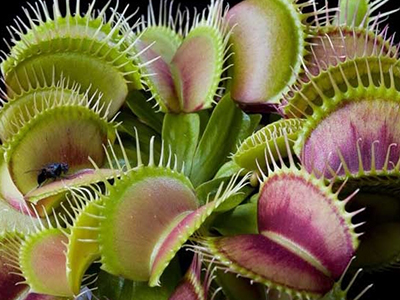
Due to the popularity of the Dionea plant, it was massively exported to Europe from its natural habitat (in 1993 alone, more than five hundred thousand samples were exported); in addition, the industrial revolution accelerated irreversible changes in the territories where the species was distributed – this led to the threat of extinction. Dionea is currently listed as a Vulnerable species and its collection from the wild is prohibited by US law.
Dionea varieties
Dionea is an insectivorous plant. Unlike its closest relative, the sundew, the flycatcher does not use a sticky trapping apparatus; in addition, the trap closes only after successive stimulation of at least two internal signaling hairs, occurring with a short break.

Such a mechanism excludes a reaction to an accidentally caught inanimate object that is useless for a plant – for example, various natural debris. Insects sit on the leaf, touching the hairs, and its edges instantly close, hiding the prey, which is digested here. The movement of the victim stimulates the glands located on the epidermis of the leaf, and they begin to secrete digestive enzymes.
The process of transformation and absorption of food takes about ten days, the chitin shell is not digested. One trap, on average, is able to catch and digest up to three insects, after which it dies.
Dionaea includes a single species known as the Venus flytrap: (D. muscipula) . The word “muscipula” is translated from Latin as “mousetrap” and is considered either a mistake by the scientist who gave the name to the plant, or a tribute to the principle of operation of the traps with which the plant feeds.
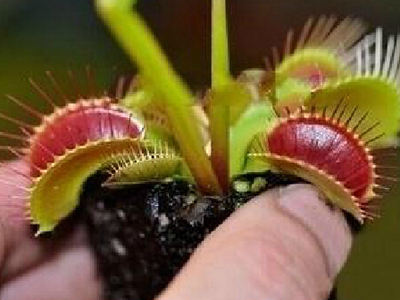
The typical form of Dionea flycatcher has light green leaves with a pinkish core, which are traps. The leaves are on long petioles, rounded, the edges of the leaves are bordered with tentacle hairs. In the center of the leaf, the hairs are short, along the edges are long. At Dionea flycatcher, the flowers are white, small, rise above rosettes of leaves, the plant blooms from May to July.
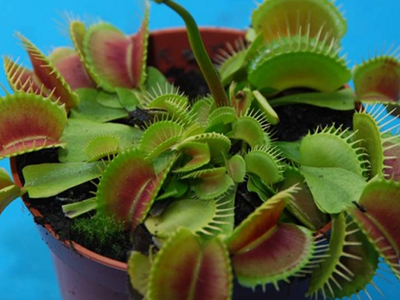
Breeders have bred various decorative varieties that successfully interbreed due to belonging to the same species, as a result of which the grower receives plant samples with interesting external differences.
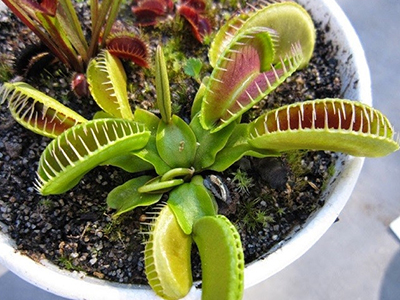
Dionea ‘Bohemian Garnet’ is a squat flower with burgundy hairs and traps in the middle.

Dionea “B-52” – in the middle of the trap, a blurry red spot, reminiscent of mixing the ingredients of the cocktail of the same name.

Dionea ‘Louchapates’ is a large cultivar with a pink colored center of the trap.

Dionea “Darwin” – distinguished by long hairs.

Dionea “Short Teeth” – relatively short hairs of various bright colors.
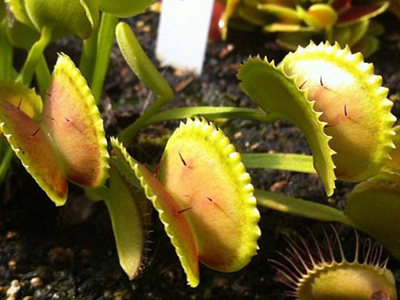
‘Clayton’s Volcanic Red’ – deep fuchsia leaves.
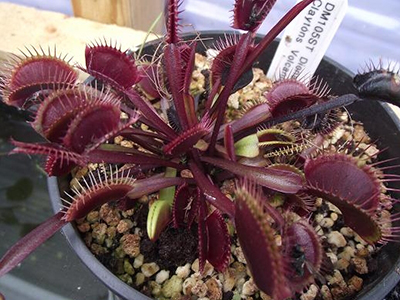
“Cupped Trap” – a rounded leaf shape that resembles a bowl.

“Dracula” – a rich crimson shade of the middle of the sheet, the frame resembles spikes or fangs.
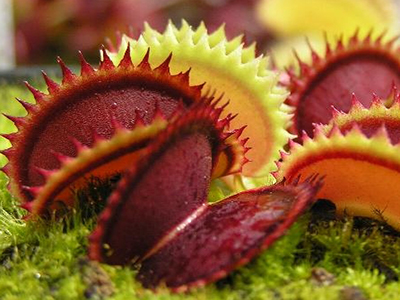
“Cross Teeth” – the hairs framing the leaf cross when the trap collapses.
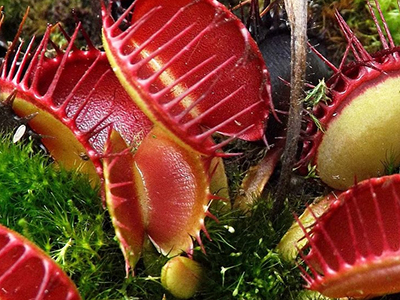
You can see in detail the varieties of Dionea in the photo.


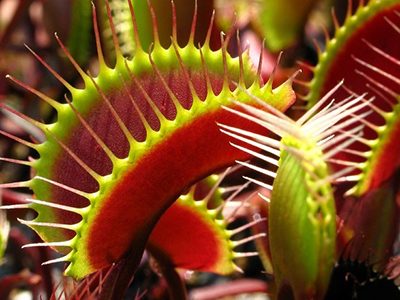
How to properly care for a home dionea
Dionea care at home is specific. The various aspects of how to properly care for a home dionea are detailed below.
Dionea needs good lighting, but she is afraid of direct sunlight. She needs natural diffused light, bright enough: the plant should receive it 6-8 hours a day. If it is not possible to put a flower on a south window with shading, you can use fluorescent lamps, placing them at a distance of 20 cm from the plant. The pot should not be turned. Humidity should be high, on hot days the plant should be sprayed.
The flower feels most comfortable in the temperature range from 13 to 20 ° C, but it needs a dormant period, so in winter the temperature is 5-10 ° C. The transition to it will be noticeable already in the fall, when the dionea stops growing, and its leaves decrease in length. During hibernation in winter, watering is rare: periodically the substrate is moistened with water of the same temperature as the environment for keeping the flower. Lighting needs to be moderated.
Watering the soil and feeding the predatory Dionea
Watering a predatory Dionea requires caution. The complete absence of minerals is mandatory, the use of tap water, even boiled or filtered, is unacceptable. Foreign impurities can reduce the care of the flycatcher to nothing: Dionea will simply die. To avoid this, you need to remember that only distilled water is suitable for irrigation. It can be found in pharmacies or at car service stations (SRT).
During the growth period (spring – summer), dionea needs abundant watering, the substrate should always be wet, it is recommended to water through the pan. Moisture should not stagnate either in the soil or in the pan, so as not to cause the plant to rot.
No less careful attitude requires the selection of soil suitable for Dionea. A good substrate is peat land with sphagnum moss. The soil should not contain mineral impurities. Fertilizers are not applied, since in nature the flycatcher receives all the necessary substances from the caught insects, and its root system is not adapted to the absorption of mineral and organic nutrients.
If the dionea flycatcher grows at home, excluding the independent capture of insects (for example, the pot is located in the room, and not on the balcony or loggia), it needs feeding. It is produced using live insects, otherwise the signal hairs inside the trap will not work, and it will not close. In size, the insect should be half or three times smaller than the leaf.
Too large insects or worms are poorly digested, rot inside the trap, causing flower diseases, they cannot be used. During the summer season, the plant should receive 2-3 feedings. Preparing the flycatcher for wintering, the grower stops feeding.
How to grow a dioea flycatcher from seeds and cuttings
Dionea can be propagated by dividing the bush, leaf cuttings. From the overgrown colonies of the flycatcher, small daughter bushes with their own roots can be separated and planted. All root sections must be treated with activated charcoal powder for sanitation. Propagation using a cutting is much more laborious: as a rule, only experienced flower growers know how to grow dionea in this way without losing a sample. One of the leaves is separated from the mother flower so that the stalk retains the white part. The cut is leveled and treated with a root, after which the cutting is placed at an angle in a mixture of peat and quartz sand and aged until growth appears under typical conditions for dionea. Often this process takes several months, in addition, the cuttings are prone to decay or infection with a fungus.
A useful and interesting experience can be such an experiment as an attempt to grow Dionea from seeds. After ripening, they are immediately sown. To do this, the seeds are scattered on the surface of the substrate, without covering them, sprayed with water from a spray bottle. The sowing container is placed in heat, withstand bright diffused light and humidity – the soil must retain water during the entire germination time, which is about half a month. 2-3 weeks after the appearance of the first sprouts, they are carefully seated. Fungicides can be used to prevent fungal infection.
This is a fairly complete description of how to grow a Dionea flycatcher from ready-made seeds.
Correct Dionea Transplant
As the bush grows, the dionea should be transplanted. It is also necessary to do this with a store-bought adult plant, as they are often found in a saline substrate. With the correct transplantation, the old soil is shaken off from the dionea, the plant is placed in the soil hole in such a way that the white part of the flower is completely immersed in the soil and the green part is touched. Soil is sprinkled around the stem, it is not necessary to crush it. Excess buildup will wash out when watering. The process requires caution: with “idle” grazing of the leaves, their lifespan is reduced. For the same reason, it is impossible to tease dionea by artificially stimulating signal hairs.
Old traps must be removed in a timely manner. Leaves that have lost viability are determined by the blackening of the surface.
If the grower is not interested in the flowering of the flycatcher, he can remove the flowers – in this case, the growth of the dionea will accelerate and new leaves will appear.
An adult acclimatized dionea is captured on video.







